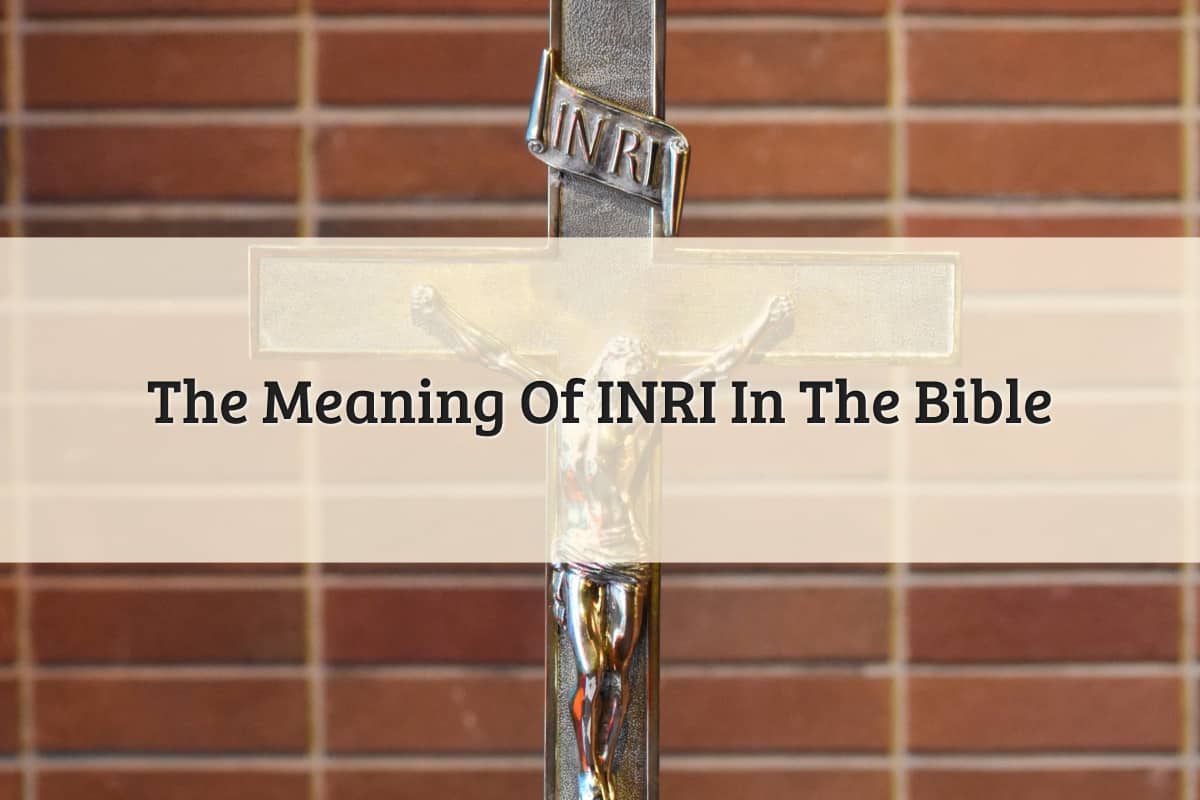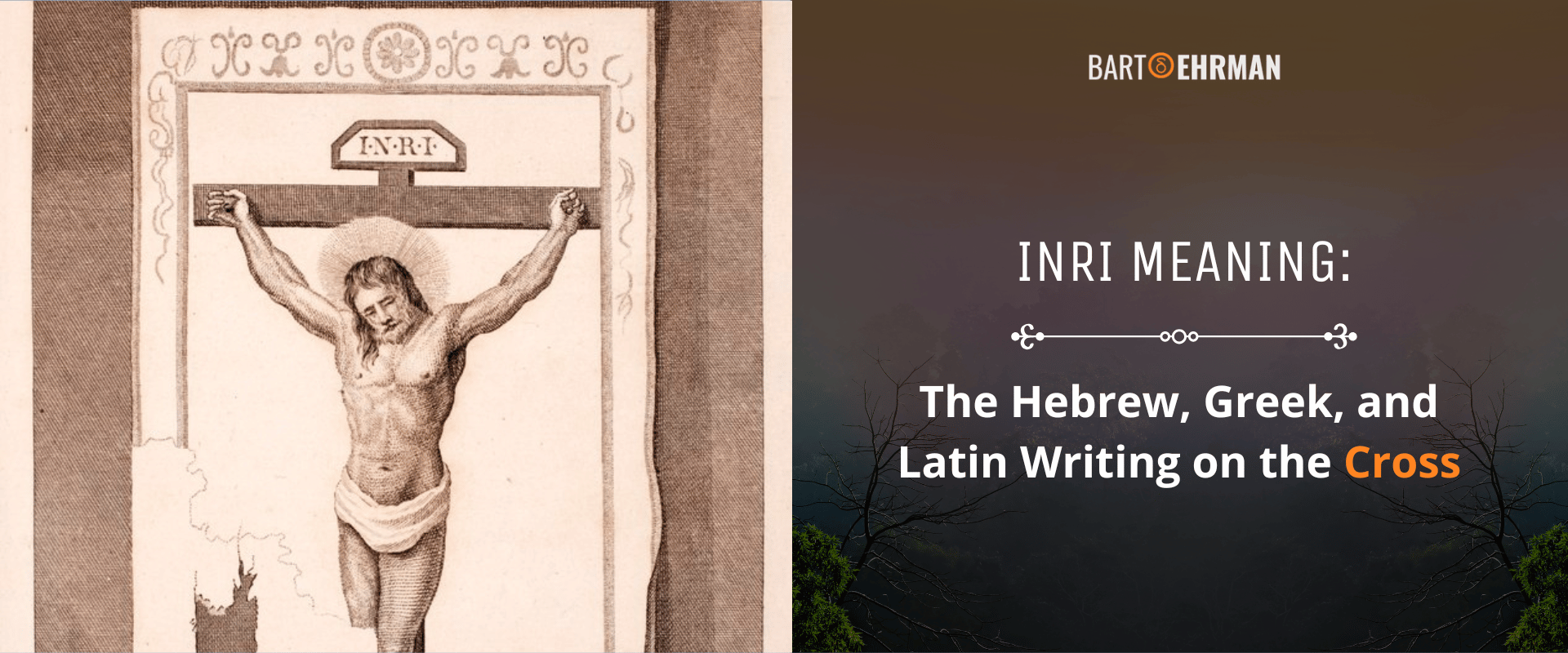INRI Meaning: What Does It Mean On The Cross?
Ever gazed upon a crucifix and wondered about the four letters often displayed above the figure of Jesus? These letters, INRI, are far more than mere decoration; they represent a pivotal declaration that speaks volumes about faith, history, and the very essence of Christianity.
The initials "INRI" represent an abbreviation, a concise form of a Latin phrase. This abbreviation is taken from the Latin phrase "Iesus Nazarenus Rex Iudaeorum," which translates to "Jesus the Nazarene, King of the Jews." This inscription was placed above Jesus' head on the cross during the crucifixion, a detail that is reported in the Gospel of John. The act of displaying a sign identifying the condemned was a common practice during Roman times. In the case of Jesus, this inscription served not only as a declaration of the charge against him but also as a statement of his perceived identity and claim to kingship.
To understand the significance of INRI, one must delve into the historical context of the crucifixion and the theological implications it holds. Here's a table summarizing key details:
- Secure Remote Iot P2p On Windows 10 Free Guide Setup
- Hdhub4u Your Guide To Free Movie Downloads Streaming In 2024
| Attribute | Details |
|---|---|
| Meaning of INRI | Iesus Nazarenus Rex Iudaeorum (Jesus of Nazareth, King of the Jews) |
| Language | Latin (The original inscription was also in Greek and Hebrew) |
| Context | Inscribed on the cross during Jesus' crucifixion, as a titulus (label) |
| Origin | Gospel of John 19:19-22 describes Pontius Pilate ordering the inscription. |
| Purpose | To identify the condemned and to mock/confirm Jesus' perceived claim to kingship |
| Significance | Central to Christian understanding of Jesus' identity and sacrifice. Symbolizes his role as Messiah. |
The placement of the INRI inscription was not a random act. It was, according to the Gospel of John, specifically ordered by Pontius Pilate. Pilate, the Roman governor, likely intended the inscription to be a mocking statement, highlighting Jesus' claim to be a king a claim that the Roman authorities viewed as seditious. Yet, for Christians, the inscription carries a completely different meaning. It is an affirmation of Jesus' identity as the Messiah, the King of Kings, and the embodiment of divine authority.
The Gospel of John 19:20 states the inscription was written in three languages: Hebrew, Latin, and Greek. This multilingual aspect likely served to ensure that the message was understood by the diverse population present in Jerusalem during the Passover. The use of these languages underscores the significance of the event, intended by the Romans to be a public display of their power and a warning against rebellion.
The meaning of INRI is deeply interwoven with the historical and theological contexts of Jesus' crucifixion. The Romans often displayed signs above those they crucified, declaring the reason for their execution. In this instance, Pilates intention was to mock Jesus' claim to kingship. However, the Gospels, and particularly the Gospel of John, portray the inscription as a proclamation of Jesus' true identity.
- Mallu Porn Alert Watch Free Videos Now
- Telugu Kannada Movies Online Where To Watch Stream Discover Now
The letters "INRI" have become an integral part of Christian iconography. They are found on countless crucifixes, paintings, and other depictions of the crucifixion, serving as a constant reminder of the sacrifice made by Jesus Christ. Moreover, the inclusion of INRI in religious art and artifacts underscores the significance of the inscription as a symbol of faith and a testament to the central tenets of Christian belief.
For Christians, the INRI inscription is a symbol of immense theological weight. It confirms Jesus' divine nature and his role as the Messiah, the prophesied king who would save his people. The inscription is a reminder of the ultimate sacrifice Jesus made for humanity, a sacrifice motivated by love, redemption, and the promise of salvation. Thus, the letters "INRI" encapsulate the essence of the Christian faith.
The interpretation of the INRI inscription is multifaceted and rich in symbolism. It signifies Jesus' identity as the prophesied messiah, the king of the Jews, as foretold in the Old Testament scriptures. The inscription also underlines Jesus' role in fulfilling the divine plan for salvation, as he bore the weight of humanity's sins through his crucifixion. Furthermore, it is interpreted as a declaration of Jesus' royal authority and divine power.
The use of crucifixes with the INRI inscription is an ancient tradition found most prevalent in the Catholic Church, but its symbolism has spread to many other Christian denominations. The prevalence of the letters "INRI" in religious art has profoundly influenced religious practices and rituals across various Christian denominations. They are present not only during the solemn observance of Good Friday but also during the joyous celebration of Easter, where the symbolism of "INRI" is interwoven into the fabric of these sacred traditions, representing both the suffering and the triumph of Jesus Christ.
This article explores the meaning of INRI, its origins, translations, and cultural relevance, providing a comprehensive understanding of this important term. The term "titulus crucis," which translates to "title of the cross," refers to the actual piece of wood upon which the inscription was written. This relic is connected to the events surrounding the crucifixion. It's important to remember that the sign itself was originally written in three languages - Greek, Latin, and Hebrew - to ensure maximum exposure and understanding.
The meaning of INRI is more than just a simple inscription on a cross; it represents the ultimate sacrifice Jesus made for humanity. Jesus' death on the cross was a pivotal moment in Christian history, and it is often seen as a symbol of love, redemption, and salvation. The initialism is an abbreviation of the latin inscription "Iesus Nazarenus Rex Iudaeorum," meaning "Jesus of Nazareth, King of the Jews."
Living out the meaning of INRI in our daily lives involves embodying Jesus' message of selfless love, sacrifice, and forgiveness. It means striving to act with compassion, empathy, and a deep understanding of the needs of others. This includes putting others' needs before our own, demonstrating grace and understanding, and continuously seeking to grow in our faith. The example of Jesus, who willingly sacrificed his life, serves as a guide for Christians who aspire to follow his teachings. This includes the act of seeking justice, advocating for the marginalized, and sharing the message of the Gospel.
The enduring presence of the INRI inscription serves as a powerful reminder of the core tenets of the Christian faith. It highlights the sacrifice of Jesus, his role as the Messiah, and the promise of salvation. Through its simplicity, the message of INRI resonates deeply, reminding believers of the profound love and sacrifice that are central to their faith.



Detail Author:
- Name : Lucinda Gaylord
- Username : emmerich.malika
- Email : eladio.davis@goodwin.org
- Birthdate : 1993-03-09
- Address : 953 Schmeler Dale Suite 999 East Garfield, RI 97173
- Phone : 681.994.8481
- Company : Farrell, Moen and Wiegand
- Job : Legal Secretary
- Bio : Architecto omnis ut atque odio pariatur et. Itaque pariatur dolor et nisi. Officia a dolores cum illo ut sunt iure velit.
Socials
linkedin:
- url : https://linkedin.com/in/rharber
- username : rharber
- bio : Ad in laudantium in et molestiae.
- followers : 5149
- following : 1056
tiktok:
- url : https://tiktok.com/@harberr
- username : harberr
- bio : Repellat vel neque natus incidunt rerum.
- followers : 6567
- following : 2594
instagram:
- url : https://instagram.com/rahsaan_harber
- username : rahsaan_harber
- bio : Impedit impedit numquam at aperiam nam necessitatibus ipsum. Neque numquam sed vero quia.
- followers : 6394
- following : 2279
twitter:
- url : https://twitter.com/rahsaanharber
- username : rahsaanharber
- bio : Vero nobis fugit non rerum. Consectetur nulla molestiae enim ratione in. Consequatur hic vero sunt rerum temporibus quibusdam aliquid eligendi.
- followers : 4746
- following : 2830